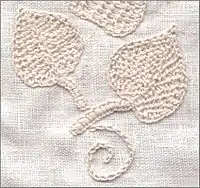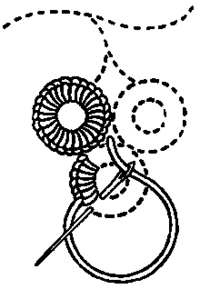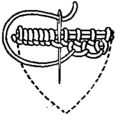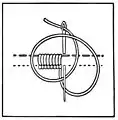Buttonhole stitch
Buttonhole stitch and the related blanket stitch are hand-sewing stitches used in tailoring, embroidery, and needle lace-making.[2]



Applications
Traditionally, this stitch has been used to secure the edges of buttonholes.[3] In addition to reinforcing buttonholes and preventing cut fabric from raveling, buttonhole stitches are used to make stems in crewel embroidery, to make sewn eyelets, to attach applique to ground fabric, and as couching stitches. Buttonhole stitch scallops, usually raised or padded by rows of straight or chain stitches, were a popular edging in the 19th century. Buttonhole stitches are also used in cutwork, including Broderie Anglaise, and form the basis for many forms of needlelace. This stitch is well represented on 16th- and 17th-century whitework items. The buttonhole stitch appeared on the Jane Bostocke sampler (1598) which is the earliest, signed sampler known to date and is presently housed in the Victoria and Albert Museum in London.[4]
Variants
Examples of buttonhole or blanket stitches include:
- Blanket stitch
- Buttonhole stitch
- Closed buttonhole stitch, in which the tops of the stitch touch to form triangles
 Detached buttonhole stitch
Detached buttonhole stitch Tailor's buttonhole stitch
Tailor's buttonhole stitch Buttonhole stitch variations
Buttonhole stitch variations Buttonhole shading
Buttonhole shading
See also
References
- Beeton, Isabella, Beeton's Book of Needlework, London, 1870
- Koll, Juby Aleyas (2019). Sarah’s Hand Embroidery Tutorials—Hand Embroidery Stitches for Everyone. Roxy Mathew Koll and Juby Aleyas Koll. p. 452. ISBN 978-93-5361-592-5.
- Sarah (2011-12-13). "Buttonhole Stitch". Sarah's Hand Embroidery Tutorials. Retrieved 2019-04-17.
- West, Deanna Hall (July 30, 2018). "A Stitch in Time: The Buttonhole Stitch and Blanket Stitch". Interweave.
Other References
External links
 Media related to Buttonhole stitch at Wikimedia Commons
Media related to Buttonhole stitch at Wikimedia Commons


